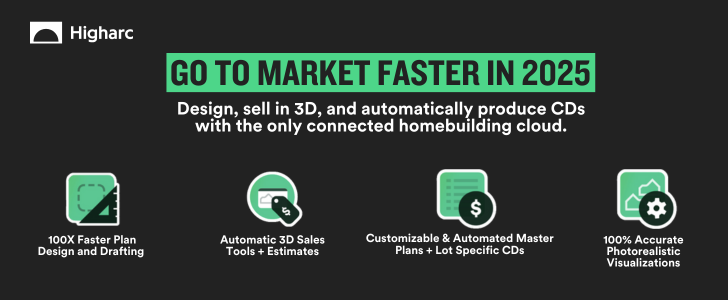Technology
Faster Builds, Better Margins: The ROI On Right-The-1st-Time Velocity
Inside the digital transformation of homebuilding: How integrated teams, shared data, and AI are turning velocity into a high-stakes profit advantage.

Spring 2025 is Supposed to Be Hot. It's Not.
The season that’s long defined itself as homebuilding’s peak is off to its slowest start in five years. April's signed new-home contracts — typically the highest of the year — slumped to levels not seen since the pandemic lockdowns of 2020. In parallel, inventory ballooned and incentives swelled, even as active listings surged to their highest level since 2019.
Across the Sunbelt, builders are undercutting the resale market with deep buy-downs and discounted upgrades, but consumer hesitancy is lingering. Affordability remains tight. Confidence is shaky. And builders are caught in the middle — stuck between slowing foot traffic, cautious buyers, and an intensifying pressure to hit pace targets and preserve margin.
It’s not just slower,” says one private builder in the Southeast. “It’s scattered. One week looks decent, the next week is a ghost town. We can’t predict anything — and that’s paralyzing when you’re trying to manage starts, inventory, and capital.”
The future – and present – of homebuilding isn’t just about building more homes. It’s about building faster, smarter, and more predictably — all while preserving margins in a market where affordability is under siege.
Carrying costs balloon with every day of delay, and builders can no longer afford rework, misaligned expectations, or legacy workflows. That’s why forward-thinking homebuilding operators are turning to digital tools beyond design or estimating point solutions. They’re embracing a deeper operational transformation: a shift from disconnected, analog systems to integrated, data-synced platforms built for speed and precision.
That transformation’s payoff? Velocity.
Agility is everything," says Ed Kubiak, Lead Builder Partner at Higharc and former homebuilding operator. "It’s not just about going fast. It’s about going fast without mistakes. That’s the difference between moving like a speedboat versus steering a cruise ship."
Kubiak and his colleague, Jennifer Hoops, Solutions Consultant at Higharc and a veteran of PulteGroup and Beazer Homes, say the ability to move quickly, accurately, and cohesively across departments is now central to builder survival. Their work at Higharc focuses on enabling that agility through shared data models, automated documentation, and AI-enhanced workflows.

What Slows You Down
Ask Hoops where builders most often lose time, and she points directly to the beginning:
We create product in a vacuum. Someone requests a design change without fully considering cost, lot fit, or build feasibility. By the time that gets figured out, you’re weeks behind schedule."
Kubiak adds:
The real bottleneck is capacity. Most drafting and architecture teams are maxed out. As soon as you ask for a change, it means someone has to drop everything. And when you finally get into the field, you realize it doesn’t build right. Then come the redlines, the rework, and the delays."
The root issue? Disconnected systems. Disconnected data. Disconnected teams.
The Price of Delay
In today’s market, every extra day adds cost. Interest carry, labor idling, storage fees, and delayed revenue recognition — it all piles up. And in a landscape of high mortgage rates and psychological buyer resistance, there’s less and less room to absorb those hits.
Builders have no more slack," Hoops says. "You can’t afford sloppy decision deployment anymore. Affordability’s tight. Buyers expect clarity. Your systems can’t be the reason you lose a deal."
This is where time becomes money — not just conceptually, but measurably. The time value of money, a core economic principle, reminds us that a dollar earned today is worth more than that earned tomorrow. For homebuilders, closing a home three weeks faster can mean tens of thousands saved in interest, overhead, and delayed revenue.
Thread vs. Twin
A key concept emerging in homebuilding’s digital transformation is the distinction between the digital twin and the digital thread.
- Digital Twin: A virtual replica of a home or system. It lets teams simulate, test, and optimize before breaking ground.
- Digital Thread: The continuous, connected data flow that links every lifecycle phase — from design to sales to permitting to construction.
Higharc’s platform bridges both, using a shared data model to keep the twin current and the thread intact – a fabric.
When Ed changes a roof pitch for cost efficiency, I can immediately see the updated plans, the cost implications, and the buyer visualization — all in one place," Hoops says.
The alternative? Spreadsheets, emails, and hope.
Aligning the Playsheet
Higharc isn’t just offering new tech; it’s translating across silos. With architecture, estimating, sales, purchasing, and construction teams often working in different systems (and languages), even simple changes can cascade into chaos.
Kubiak offers a real-life homebuilding operator case in point:
A builder came to us with a distressed land deal. They needed product in 30 days or they’d lose it. Normally that’s a 90-day process minimum. With Higharc, they went from design to sales to construction in under a month — and closed homes in the same fiscal year. That’s velocity."
This isn’t theoretical. Builders using integrated platforms eliminate 3-6 weeks of soft cycle time, shave days off field schedules, and reduce variance-driven delays that typically impact 1 in 10 homes.
Less Rework, More Margin
Rework is expensive. It kills margins, saps labor, and creates friction with buyers. Worse, it eats into the attention span of already-overloaded field managers.
Half-pitch roof tweaks, shower pan size changes — these things shouldn’t cause a 4-week delay and $2,000 in rework," Kubiak says. "But when your systems don’t talk, a small change means 50 manual updates across teams. That’s when you miss something."
Hoops adds:
In a connected platform, we can test the change, see the impact in real time, and deploy accurate docs across sales, estimating, and construction immediately. That’s a velocity gain that protects margin."
Soft Savings, Hard Impact
Some time savings don’t appear on the field schedule, but still matter.
Hoops recalls a builder bogged down in Architectural Review Board cycles.
She scheduled the first and last ARB appointments on the same day. Made the first pitch, took feedback, made the changes in Higharc during the lunch break, and got approval before the end of the day. That’s a 30-day soft cycle gain."
It’s not just about saving time. It’s about reclaiming control, and for homebuilders, evolving from a hodgepodge of loosely-coordinated competencies into a business and operating system.
Human Intelligence, Scaled
Despite the rise of AI, Hoops and Kubiak are adamant: people are still the differentiator. The goal isn’t to replace them — it’s to free them up.
Our goal isn’t to automate the estimator out of a job," Kubiak says. "It’s to let them stop counting outlets and start leading value engineering. Same for architecture. Let your team shape product strategy, not chase redlines."
The shift from task fulfillment to strategic value is what digital transformation is really about. As MIT’s George Westerman and Didier Bonnet write, digital masters combine "digital capability" with "leadership capability." It’s not enough to have tools. You have to build the culture, the communication, and the shared commitment to operate differently.
Builders don’t fail at tech because the software doesn’t work," Hoops says. "They fail because they try to replicate the old business inside the new system. You have to change the way you think."
The Competitive Mandate
In today’s – not to mention tomorrow's – market, the ROI of velocity isn’t optional. It’s existential.
Faster building cycles protect margins. Connected data reduces errors. AI-enhanced systems empower people to do what only people can do: solve, create, and lead.
As buyers demand speed, certainty, and personalization, builders who invest in the digital thread — not just digital twins — will find themselves not just surviving but thriving.
Velocity isn’t just a metric. It’s a competitive advantage.
MORE IN Technology
Pre-Development Is Where Velocity Happens: Here's How
In a high-cost, high-risk market, developers and builders must find every dollar and day they can save. Integrated digital pre-construction tools are quietly delivering outsized impact — if you know where to look.
The Future-Proof Homebuilder Operates A Unified Workflow
Hyphen Solutions CEO Felix Vasquez lays out why fragmented workflows are dragging builders down—and how connected data streams can turn the tide.
How Tim O’Brien Homes Is Re-Wiring Its Buyers' Experience
In a market defined by hesitation, speed and certainty separate survivors from stragglers. Tim O’Brien Homes shows how technology can deliver both.


